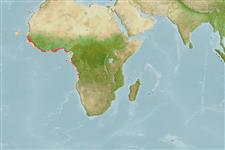Common names from other countries
>
Eupercaria/misc (Various families in series Eupercaria) >
Sciaenidae (Drums or croakers)
Etymology: Pseudotolithus: Greek, pseudes = false + greek, otos = ear + Greek, lithos = stone (Ref. 45335).
More on author: Cuvier.
Issue
The species Pseudotolithus brachygnathus Bleeker, 1863 is considered as valid in Eschmeyer (CofF ver. Jul. 2010: Ref. 84883) according to Afonso et al. (1999: Ref. 34088).
Environment: milieu / climate zone / depth range / distribution range
Ekologi
laut; payau dasar (demersal); kisaran kedalaman 0 - 150 m. Tropical; 16°N - 17°S
Eastern Atlantic: Mauritania (Ref. 5377) to Angola.
Length at first maturity / Size / Weight / umur
Maturity: Lm 30.3 range ? - ? cm
Max length : 230 cm TL jantan/; (Ref. 2683); common length : 85.0 cm TL jantan/; (Ref. 2683); Berat maksimum terpublikasi: 12.5 kg (Ref. 40637)
deskripsi pendek
Kunci identifiaksi (pengenalan) | Morfologi | Morfometrik
Duri punggung (Keseluruhan (total)) : 11; duri punggung lunak (Keseluruhan (total)) : 25 - 27. Diagnosis: body elongated; mouth short and large, chin without barbels; teeth fine (Ref. 5377). Dorsal with 10 spines in the first part; second part of dorsal fin with 1 spine and 25-27 soft rays; second anal spine about half the length of the 1st anal fin soft ray; pectoral fins short, about 18-20% SL; maxilla extending to posterior half of eye; 8-10/1/5-7 (total 14-18) gill rakers on 1st gill arch; gill rakers short, about as long as gill filament at angle between lower and upper part of gill arch (Ref. 81656).
Found over mud and sandy bottoms, enters coastal lagoons and estuaries. Feeds on small fish and crustaceans. Flesh highly appreciated; caught by artisanal fishers (Ref. 5377).
Life cycle and mating behavior
Maturities | Reproduksi, perkembang biakan | Spawnings | Egg(s) | Fecundities | Larva
Sasaki, K., 1993. Corvina senegalla Cuvier, a senior synonym of Pseudotolithus (Pseudotolithus) brachygnathus Bleeker (Sciaenidae: Periciformes). Jap. J. Ichthyol. 40(3):361-362. (Ref. 10077)
Status IUCN Red List (Ref. 130435)
CITES (Ref. 128078)
Not Evaluated
ancaman kepada manusia
Harmless
penggunaan manusia
Perikanan: nilai komersial kecil; Ikan buruan: ya
Alat, peralatan
laporan khas
muat turun XML
Sumber internet
Estimates based on models
Preferred temperature (Ref.
115969): 18.6 - 27.9, mean 25.7 (based on 120 cells).
Phylogenetic diversity index (Ref.
82804): PD
50 = 0.5156 [Uniqueness, from 0.5 = low to 2.0 = high].
Bayesian length-weight: a=0.00851 (0.00413 - 0.01752), b=3.08 (2.91 - 3.25), in cm Total Length, based on LWR estimates for this (Sub)family-body shape (Ref.
93245).
Trophic level (Ref.
69278): 3.9 ±0.67 se; based on food items.
Daya lenting (Ref.
120179): Rendah, Waktu penggandaan populasi minimum 4.5 - 14 tahun (Assuming tmax>10).
Fishing Vulnerability (Ref.
59153): Very high vulnerability (90 of 100).
Climate Vulnerability (Ref.
125649): Very high vulnerability (90 of 100).
